Key Takeaways
- Brittanys are energetic, requiring at least an hour of exercise daily.
- They are excellent with families and other pets due to their friendly nature.
- Expect some challenges, like separation anxiety, if left alone for too long.
- Brittanys are not hypoallergenic and do shed moderately.
- Adopting a Brittany is ideal for active, outdoorsy families.
The Captivating World of Brittany Rescue & Adoption
Imagine a dog that combines energy, intelligence, and a love for outdoor adventures. That’s the Brittany for you! Originally bred for hunting in the Brittany region of France, these dogs have become beloved family companions around the world. Adopting a Brittany can bring joy and excitement to your life, but it’s important to understand what you’re getting into.
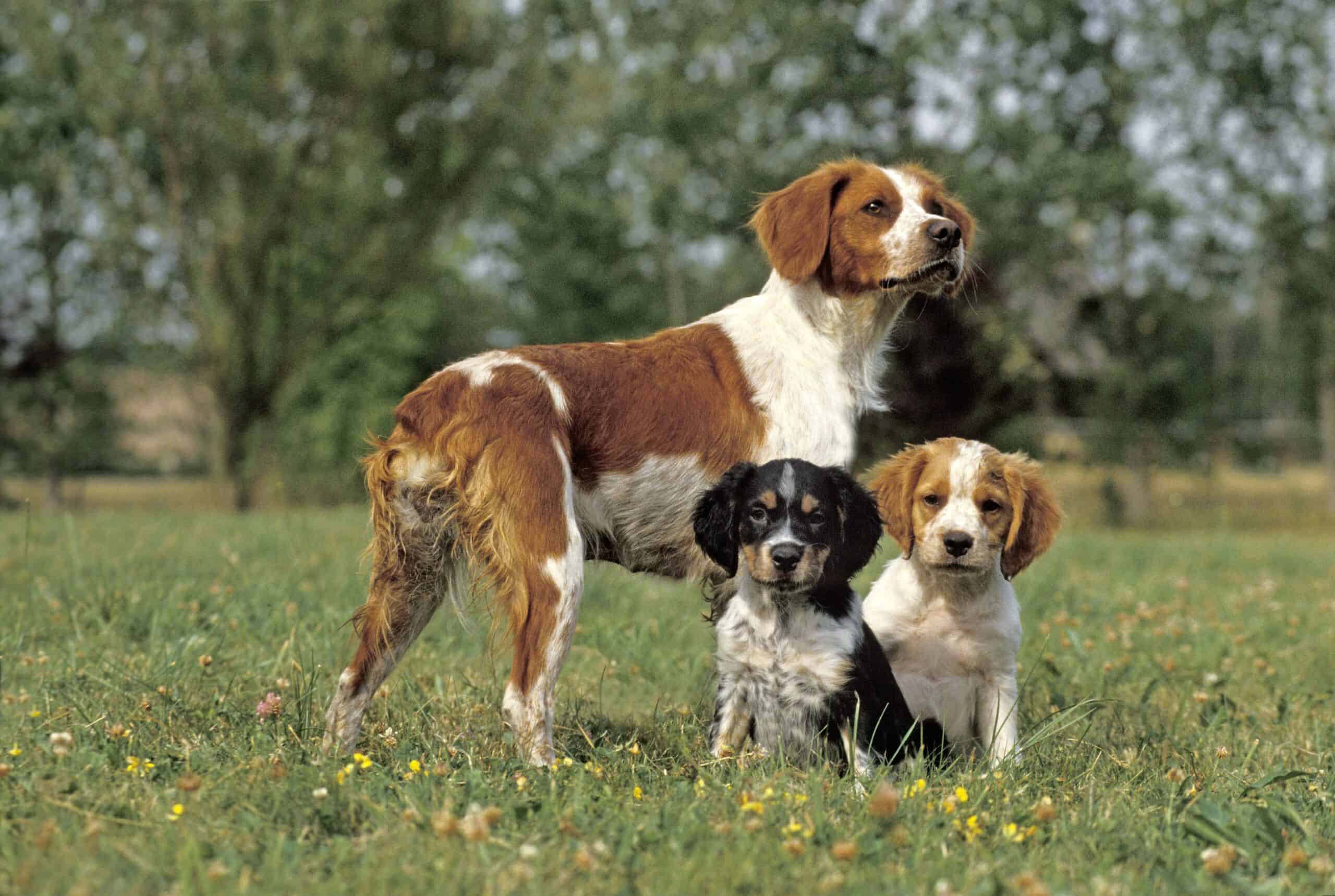
“Brittany Spaniel Dietary Needs and …” from americannaturalpremium.com and used with no modifications.
Brittany Spaniel Breed History and Characteristics
The Brittany is a versatile breed, known for its keen hunting instincts and affectionate nature. These dogs were initially bred as bird hunters, excelling in flushing and retrieving game. Over the years, their friendly demeanor and playful spirit have made them popular family pets.
“With their beautifully patterned coat and boundless energy, Brittanys are a sight to behold. They thrive in active households where they can participate in a variety of outdoor activities.”
Weighing between 30 to 40 pounds and standing about 17 to 20 inches tall, Brittanys are medium-sized dogs. Their high intelligence and eagerness to please make them relatively easy to train, although their independent streak can sometimes pose a challenge.
Most importantly, Brittanys require regular exercise and mental stimulation to keep them happy and healthy. They are not suited for sedentary lifestyles, and potential adopters should be prepared to meet their physical and mental needs. For those considering other breeds, you might also be interested in learning about the Beagle dog breed, which also requires regular activity and attention.
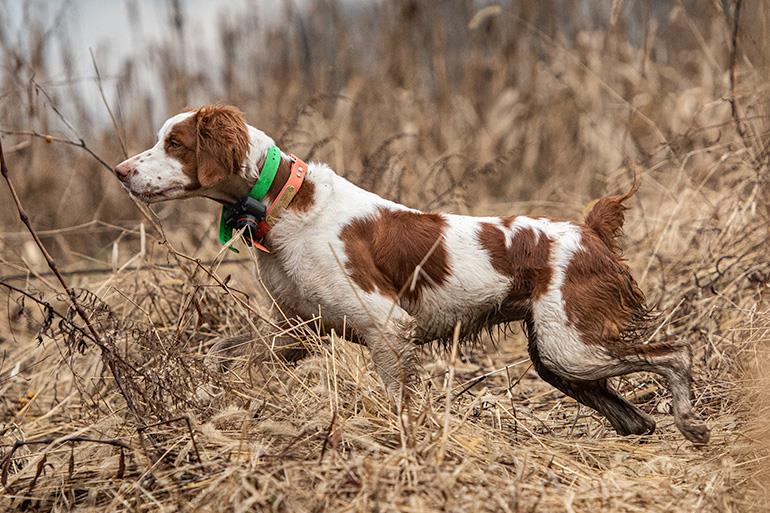
“Brittany Gun Dogs: Why They Are Popular …” from www.gundogmag.com and used with no modifications.
Relation to Pointers
The exact origin of the Brittany is shrouded in mystery, but it is believed to have developed in the mid-1800s in the Brittany region of France[1][5]. English hunters traveling to Brittany for woodcock hunting often left their well-trained Pointers and Setters behind at the end of each season. Local residents likely bred these dogs with their native spaniel-type dogs, resulting in the variety of colors seen in Brittanys today[1].
Despite their “spaniel” name, Brittanys are more closely related to Pointers and Setters than to flushing spaniels[2]. This genetic similarity is reflected in their hunting style, as they are more likely to point at hidden birds rather than flush them out. In recognition of this distinction, the breed officially dropped the “spaniel” from its name in 1982 when the American Kennel Club changed it to simply “Brittany”[3]. This change also acknowledged the breed’s versatility as a utility gun dog, capable of hunting, pointing, flushing, and retrieving game[3]. The transition to America brought about some changes in the breed, both physically and behaviorally. American Brittanys tend to be larger and more energetic than their European counterparts, and the black coloration is disqualified in American and Canadian show rings[1][7].
Why Consider Adopting a Brittany?
There are numerous reasons why adopting a Brittany might be the perfect choice for you and your family. First, their friendly and outgoing nature makes them great companions for both children and adults. They are known to be gentle and patient, which makes them suitable for households with young kids.
Besides that, their intelligence and versatility mean they can excel in various activities, from agility training to obedience competitions. This makes them a great match for active families who enjoy spending time outdoors and engaging in dog sports.
Moreover, adopting a Brittany from a rescue can be a rewarding experience. Many dogs in shelters are looking for a second chance at a loving home, and by adopting, you are giving them that opportunity.
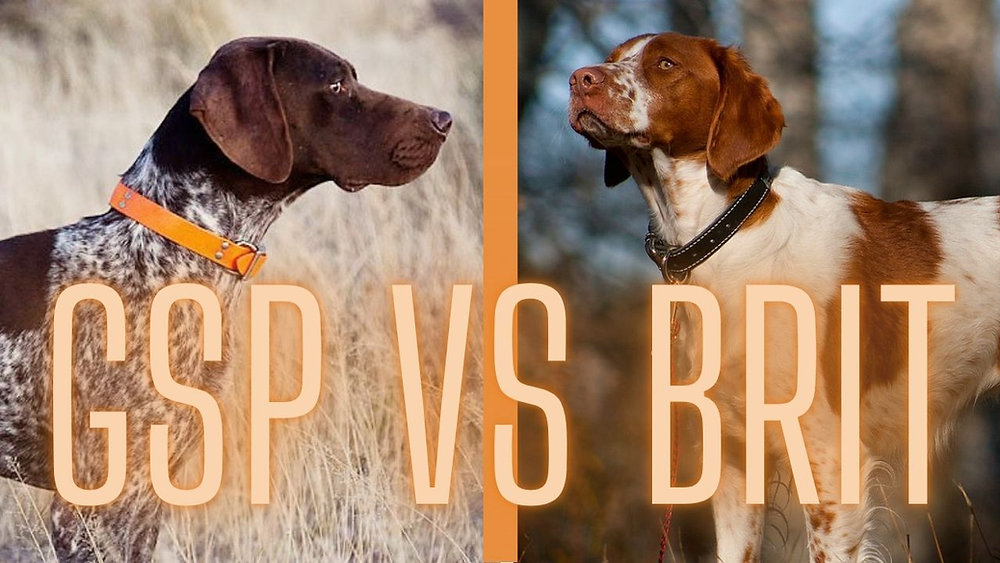
“The German Shorthaired Pointer is a …” from www.simplehunts.com and used with no modifications.
Brittany Compared to Pointers
Brittany Spaniels, despite their name, are more closely related to pointers than to spaniels. Here’s a comparison of Brittanys with similar pointer breeds:
Size and Appearance
Brittanys are smaller than most pointers, standing 17-20 inches tall and weighing 30-40 pounds[1]. In contrast, English Pointers are larger, measuring 23-28 inches in height and weighing 45-75 pounds[1]. Brittanys have a compact build with a unique rolling gait, while pointers typically have a longer, leaner body structure[4].
Hunting Style
Both Brittanys and pointers are excellent hunting dogs, but they have some differences:
Pointing:
Brittanys and pointers are strong pointers, but Brittanys may not be as natural at backing (honoring another dog’s point) as some pointer breeds[4].
Range:
Brittanys generally work at a medium range, while some pointer breeds, especially those bred for field trials in the US, may range farther[4].
Versatility:
Brittanys are considered more versatile, often excelling in pointing, flushing, and retrieving[4]. Pointers typically specialize more in pointing and may require additional training for retrieving.
Temperament
Brittanys and pointers share some temperament traits but differ in others:
Both breeds are intelligent, affectionate, and willing to please[1].
Brittanys tend to be more sensitive and may “sulk” if corrected too harshly[4].
Pointers are often more independent and may be more challenging to train for some handlers[5].

“Brittany (Brittany Spaniel) Dog Breed …” from www.petmd.com and used with no modifications.
Family Compatibility
Both breeds are generally family-friendly, but Brittanys are often considered better all-around family dogs:
Brittanys tend to bond well with all family members, while some pointers may form a stronger bond with one person[5].
Brittanys are typically more adaptable to family life and may be better suited for homes that want a part-time hunting dog and full-time family pet[5].
In summary, while Brittanys share many characteristics with pointer breeds, they offer a unique combination of pointing ability, versatility, and family-friendly temperament in a smaller package.
Brittany as a Flusher and Swimmer
The Brittany’s history as a hunting dog has endowed it with impressive skills as both a flusher and a swimmer. These abilities make them unique among the spaniel breeds and add to their appeal for active families and outdoor enthusiasts. For those interested in other unique dog breeds, the Basenji dog also offers fascinating traits worth exploring.
Understanding the Flushing Instinct
Flushing is the act of driving game, such as birds, out of hiding so that they can be caught. Brittanys have a natural instinct for this task, which is why they have been favored by hunters for generations. Even if you’re not a hunter, understanding this instinct can help you provide the right activities and training to keep your Brittany engaged and happy.
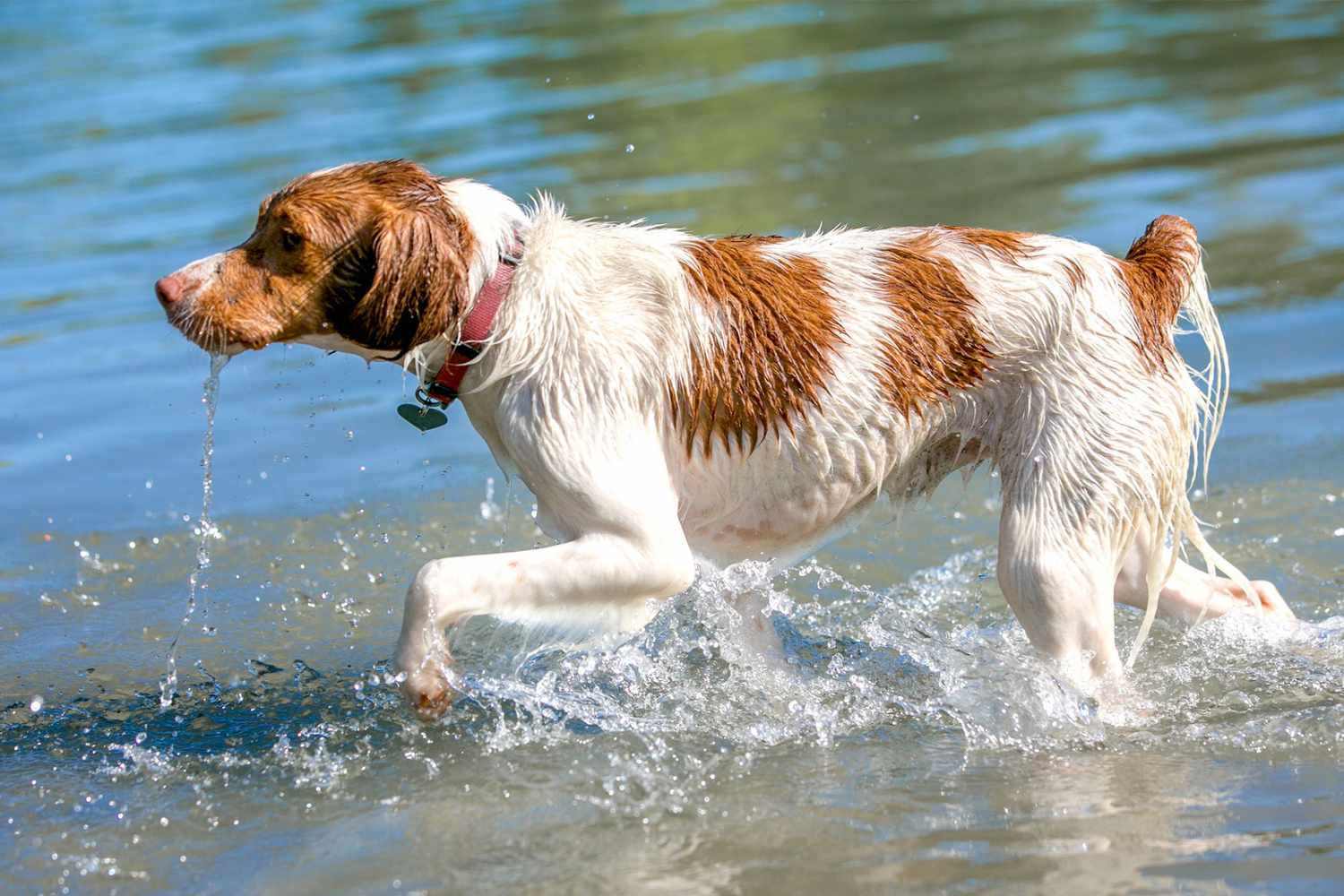
“Brittany (Brittany Spaniel) Dog Breed …” from www.dailypaws.com and used with no modifications.
The Swimming Proficiency
In addition to their flushing skills, Brittanys are also proficient swimmers. They enjoy water activities and can be a great companion for swimming, boating, or even just playing fetch at the beach. Their strong swimming ability is a testament to their versatility and adaptability, making them suitable for a variety of environments.
Training and Living with a Brittany
Training a Brittany requires patience, consistency, and positive reinforcement. These dogs are eager to learn and respond well to training methods that involve rewards and praise. However, their independent nature means they may occasionally test boundaries, so it’s important to establish yourself as a confident and consistent leader.
Living with a Brittany can be a joyful experience if you are prepared for their high energy levels and need for regular exercise. They thrive in environments where they can run, play, and explore, so having access to a secure yard or nearby parks is beneficial.
- Start training early to instill good behavior and social skills.
- Engage them in activities that challenge their mind and body, such as agility courses or interactive toys.
- Ensure they receive plenty of daily exercise to prevent boredom and destructive behavior.
Training Techniques for Success
To successfully train a Brittany, focus on consistency and positive reinforcement. Use treats, toys, and praise to reward good behavior and reinforce commands. Short, frequent training sessions are often more effective than long, drawn-out ones.
Additionally, socialization is key to raising a well-adjusted Brittany. Introduce them to different people, animals, and environments from an early age to build their confidence and reduce the risk of timidity or anxiety.
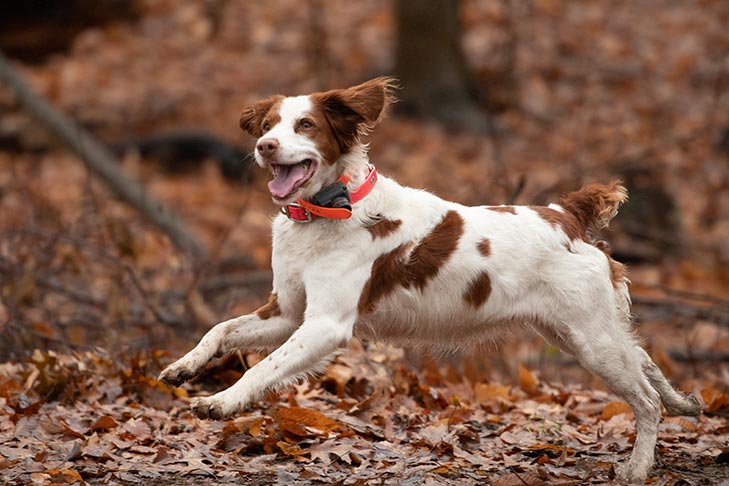
“Brittany Facts: 8 Things To Know About …” from www.akc.org and used with no modifications.
Energy Levels and Exercise Needs
Brittanys are high-energy dogs that require at least an hour of vigorous exercise each day. This can include activities such as running, hiking, playing fetch, or participating in dog sports. Providing them with enough physical activity is crucial for their well-being and helps prevent behavioral issues caused by boredom.
Living Space Requirements
While Brittanys can adapt to various living environments, they do best in homes where they have access to outdoor space. A fenced yard allows them to safely burn off energy, but they can also thrive in apartments if their exercise needs are met through regular walks and trips to the park.
- Ensure your home is safe and secure, with no escape routes for a curious and adventurous Brittany.
- Provide them with a comfortable space indoors where they can relax and feel secure.
Pros and Cons of Brittany Adoption
- Pros: Friendly and sociable, great with children and other pets, intelligent and easy to train, excellent companions for outdoor activities.
- Cons: High energy levels require regular exercise, prone to separation anxiety if left alone for long periods, not hypoallergenic, moderate shedding.
Adopting a Brittany can be a fulfilling experience, but it’s essential to weigh the pros and cons to ensure this breed is the right fit for your lifestyle. By understanding their needs and characteristics, you can provide a loving and supportive home for your new furry friend.
Advantages of Adoption
Adopting a Brittany comes with numerous benefits that make them a delightful addition to any family. Their friendly and sociable nature ensures they get along well with people of all ages, making them perfect companions for children and adults alike. Brittanys are known for their intelligence and eagerness to learn, which makes training them an enjoyable and rewarding experience.
Moreover, adopting a Brittany from a rescue or shelter gives a deserving dog a second chance at a happy life. These dogs often have a lot of love to give and are grateful for the opportunity to be part of a family. Adoption fees are typically lower than purchasing a puppy from a breeder, and many rescue organizations include initial veterinary care in the adoption process.

“Brittany Spaniel Pros And Cons | Should …” from www.youtube.com and used with no modifications.
Potential Challenges to Consider
While there are many advantages to adopting a Brittany, it’s essential to be aware of the potential challenges you may face. Their high energy levels require regular exercise and mental stimulation, which can be demanding for some families. Without adequate outlets for their energy, Brittanys may become bored and resort to destructive behaviors. For more detailed insights, you can read this Brittany breed guide.
Another challenge is their tendency to experience separation anxiety. Brittany Spaniels are highly social dogs that thrive on companionship and may become anxious if left alone for extended periods. It’s important to provide them with plenty of attention and consider doggy daycare or pet sitters if you have a busy schedule.
- They may not be suitable for families with limited time for exercise and engagement.
- Separation anxiety can lead to excessive barking or chewing.
- They are not hypoallergenic and do shed moderately.
By understanding these challenges and preparing to address them, you can ensure a harmonious relationship with your Brittany.
Brittany as a Family Pet
Brittanys are known for their affectionate and gentle nature, making them excellent family pets. They bond closely with their human companions and are always eager to participate in family activities. Whether it’s a game of fetch in the backyard or a hike through the woods, a Brittany is happiest when surrounded by loved ones.
Their playful demeanor and high energy levels make them particularly appealing to families with children. They can keep up with active kids and provide endless entertainment with their antics.
Compatibility with Families and Children
“Brittany Spaniels are incredibly patient and gentle with children, making them ideal playmates. Their friendly disposition ensures they get along well with everyone in the family, including other pets.”
It’s important to teach children how to interact with dogs safely and respectfully. Supervision is always recommended, especially with younger children, to prevent any accidental roughhousing that could lead to injury.
Additionally, early socialization and training can help ensure a Brittany grows up to be a well-mannered and confident family member.
:strip_icc()/brittany-dog-4584350_FINAL-6ad29bc54d4d472da52d5351c7830813.jpg)
“Brittany: Dog Breed Characteristics & Care” from www.thesprucepets.com and used with no modifications.
Interaction with Other Pets
Brittanys generally get along well with other pets, including dogs and cats. Their sociable nature means they enjoy having playmates, and they can form strong bonds with other animals in the household. However, it’s crucial to introduce them to new pets gradually and under controlled circumstances to ensure a positive experience for everyone involved.
Due to their hunting background, it’s essential to supervise interactions with smaller animals, such as birds or rodents, to prevent any instinctual chasing behavior. With proper training and socialization, a Brittany can coexist peacefully with a variety of pets.
Can Brittanys Stay Home Alone?
Brittanys thrive on companionship and can become anxious when left alone for long periods. Their social nature means they prefer to be around people or other animals, and they may develop separation anxiety if their need for interaction isn’t met.
Handling Separation Anxiety
Separation anxiety can manifest in various ways, such as excessive barking, destructive chewing, or attempts to escape. To prevent or alleviate separation anxiety, it’s important to establish a consistent routine and provide mental and physical stimulation before leaving your Brittany alone.
- Gradually increase the time spent away from home to help them adjust.
- Provide interactive toys or puzzles to keep them occupied.
- Consider hiring a dog walker or using doggy daycare services.
By taking these steps, you can help your Brittany feel more comfortable and secure when left alone.
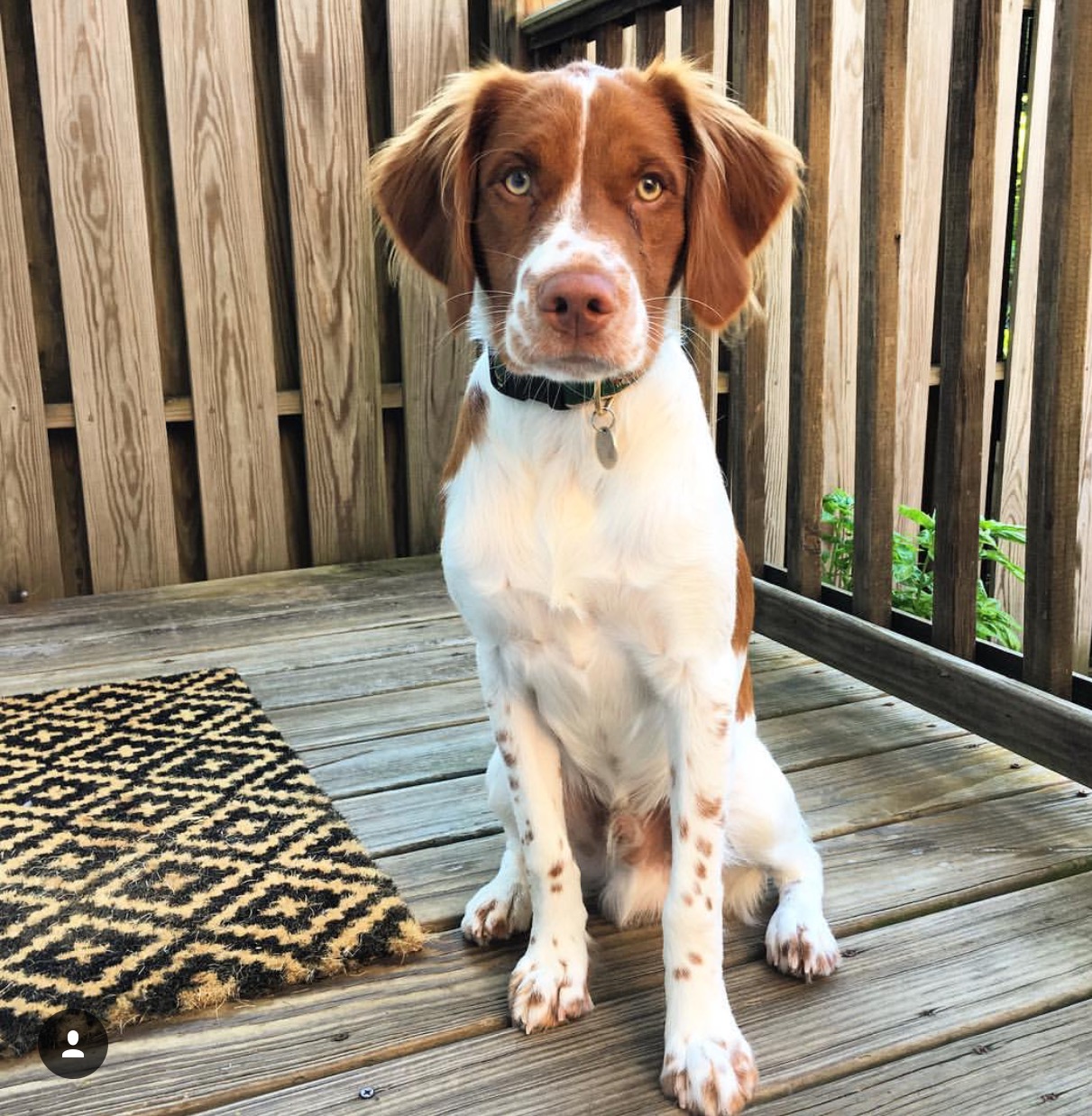
“You started with a Brittany?!?” — A …” from www.amanandhisbirddog.com and used with no modifications.
Recommended Alone Time
While every dog is different, it’s generally recommended that Brittanys not be left alone for more than four to six hours at a time. If you have a busy schedule, consider enlisting the help of a pet sitter or dog walker to break up the day and provide your dog with some companionship and exercise.
Hypoallergenic Concerns and Grooming
It’s important to note that Brittanys are not hypoallergenic. They have a moderate shedding level, which may be a concern for individuals with allergies. Regular grooming can help manage shedding and keep your Brittany’s coat healthy and clean.
Shedding Patterns and Allergy Considerations
Brittanys have a dense, medium-length coat that requires regular brushing to prevent tangles and matting. While they shed moderately throughout the year, they may experience heavier shedding during seasonal changes.
- Brush your Brittany at least once a week to remove loose hair and dirt.
- Consider using a de-shedding tool during peak shedding seasons.
- Regular baths can help reduce allergens and keep their coat fresh.
If you or a family member has allergies, consult with an allergist to determine if a Brittany is a suitable pet for your household.

“Delatite Brittanys” from delatitebrittanys.com and used with no modifications.
Grooming Needs and Tips
In addition to regular brushing, Brittanys benefit from routine grooming to maintain their overall health and appearance. This includes trimming their nails, cleaning their ears, and brushing their teeth. Establishing a grooming routine early on can help your Brittany become comfortable with the process and ensure they look and feel their best.
Brittany Compared to Popular Spaniels
When considering a Brittany, it’s helpful to compare them to popular spaniel breeds to determine which might be the best fit for your lifestyle. Brittanys are often compared to Springer Spaniels, Cocker Spaniels, and Field Spaniels due to their similar size and appearance. However, there are key differences in their energy levels, temperament, and grooming needs.

“Spaniel Showdown- Brittany vs. Springer …” from cl.pinterest.com and used with no modifications.
Brittany Spaniel vs. Springer Spaniel
When comparing Brittanys to Springer Spaniels, the first noticeable difference is in their energy levels. While both breeds are active, Brittanys are particularly high-energy and require more exercise to stay happy. Springer Spaniels, on the other hand, are slightly more laid-back, making them a better choice for families who prefer a more relaxed lifestyle.
In terms of size, Springer Spaniels are generally larger, weighing between 40 to 50 pounds compared to the Brittany’s 30 to 40 pounds. Both breeds are known for their friendly nature and make excellent family pets, but the Brittany’s intense need for physical activity can be a deciding factor for potential adopters.

“Spaniels – Ore Bucket Kennels” from orebucketkennels.com and used with no modifications.
Brittany Spaniel vs. Cocker Spaniel
Cocker Spaniels, with their silky coats and soulful eyes, are known for their affectionate and gentle demeanor. They are smaller than Brittanys, typically weighing between 20 to 30 pounds. While both breeds are friendly and good with children, Cocker Spaniels are more prone to separation anxiety and may require more attention to grooming due to their longer coats.
Brittanys, being more energetic, need more exercise and outdoor activities. If you’re looking for a dog that can keep up with an active lifestyle, a Brittany might be the better choice. Conversely, if you prefer a dog that enjoys indoor companionship and doesn’t require as much exercise, a Cocker Spaniel could be ideal.
Brittany vs. Field Spaniel
Field Spaniels are a lesser-known breed compared to Brittanys, but they share some similarities. Both breeds are medium-sized and known for their intelligence and friendly nature. Field Spaniels are generally calmer and more reserved than Brittanys, making them suitable for families who want a more composed pet.
While Brittanys excel in high-energy activities and sports, Field Spaniels are content with moderate exercise and enjoy spending time indoors with their families. If you have a quieter household and prefer a dog that is less demanding in terms of activity, a Field Spaniel might be a better match.
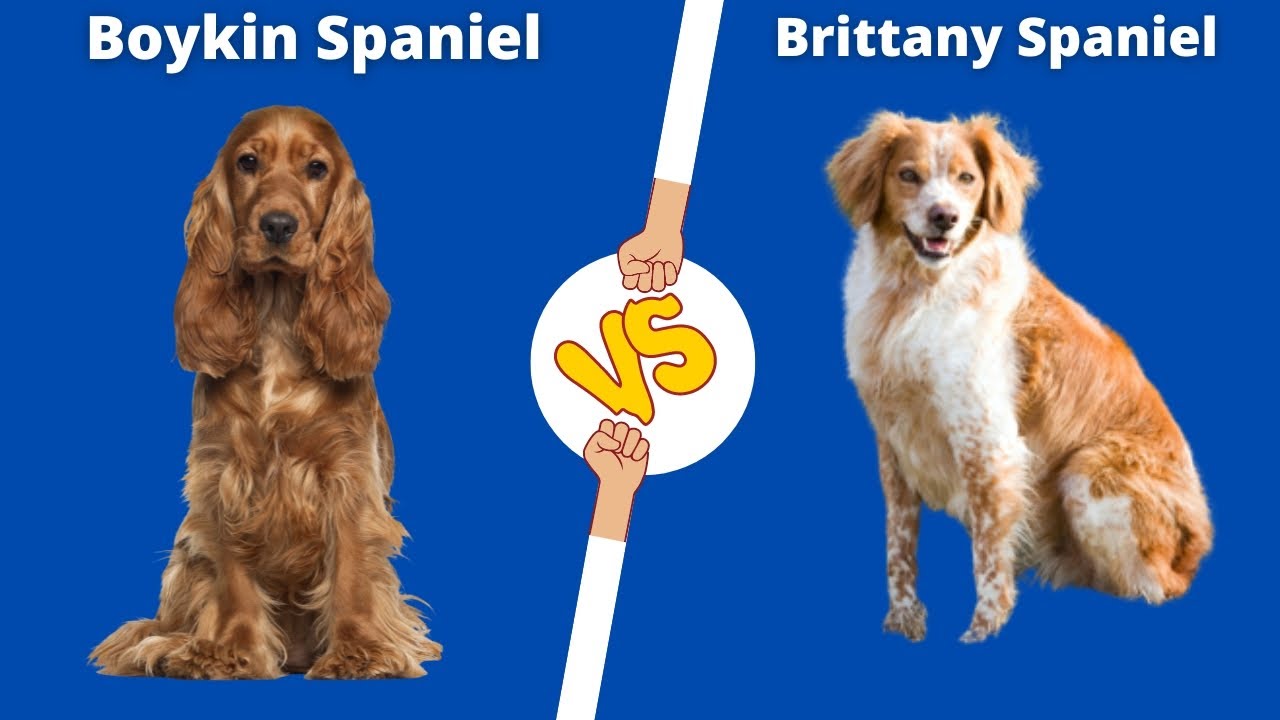
“Boykin Spaniel VS Brittany Spaniel …” from www.youtube.com and used with no modifications.
Brittany vs. Boykin Spaniel
Boykin Spaniels are similar in size to Brittanys, weighing between 25 to 40 pounds. Both breeds are known for their hunting abilities and energetic nature. However, Boykin Spaniels tend to be more water-loving and may excel in activities like swimming and retrieving in water.
While both breeds are excellent family pets, the Boykin Spaniel’s love for water might make it a better choice for families who enjoy water-based activities. Brittanys, with their high energy levels and versatile abilities, are well-suited for a variety of outdoor adventures.
Which Breed Suits Your Lifestyle?
Choosing the right spaniel breed depends on your lifestyle and preferences. Consider your activity level, living space, and the amount of time you can dedicate to exercise and grooming. Brittanys are ideal for active families who enjoy outdoor adventures, while spaniel breeds may suit those who prefer a more relaxed pace.
Ultimately, the best breed for you is one that aligns with your lifestyle and can thrive in your home environment. Spend time researching each breed and, if possible, meet them in person to get a better sense of their temperament and energy levels.
Is the Brittany Suitable for First-Time Owners?
Brittanys can be suitable for first-time dog owners, provided they are prepared for the breed’s high energy levels and need for regular exercise. Their friendly and eager-to-please nature makes them relatively easy to train, but they do require a firm and consistent approach.
First-time owners should be ready to invest time in training and socialization to ensure their Brittany grows into a well-behaved and confident dog. It’s also important to provide plenty of mental and physical stimulation to prevent boredom and destructive behaviors. For more insights on this breed, you can visit Daily Paws.
Evaluating the Match for First-Time Pet Owners
If you’re a first-time pet owner considering a Brittany, assess your ability to meet their exercise and companionship needs. Be honest about your lifestyle and whether you can commit to providing the necessary outlets for their energy. With the right preparation and dedication, a Brittany can be a rewarding and loving addition to your family. For more insights, you might want to explore how a Beagle compares in temperament and needs.
Conclusion: Making a Safe Space for Your Brittany
Creating a safe and nurturing environment for your Brittany is crucial for their happiness and well-being. Ensure your home is equipped to handle their energy levels, with secure spaces for play and exploration. Establish a routine that includes regular exercise, training, and socialization to help them thrive.
By understanding the unique characteristics and needs of the Brittany, you can provide a loving home where they can flourish. Whether you’re adopting or purchasing from a breeder, the joy and companionship a Brittany brings to your life are well worth the effort. If you’re considering other breeds, you might want to explore the Basset Hound rescue and adoption options as well.
Frequently Asked Questions (FAQ)
Here are some common questions potential Brittany owners often ask:
How much exercise does a Brittany require daily?
Brittanys need at least an hour of vigorous exercise each day. This can include activities like running, hiking, playing fetch, or participating in dog sports. Providing enough physical activity is crucial to prevent boredom and ensure their overall well-being. For those considering other breeds, you might find the Beagle’s exercise needs interesting as well.
Are Brittanys good with young children?
Yes, Brittanys are known for their friendly and gentle nature, making them excellent companions for young children. They enjoy playtime and are generally patient, but it’s important to supervise interactions and teach children how to interact with dogs respectfully.
What is the average lifespan of a Brittany and how does it compare to spaniels?
The average lifespan of a Brittany is 12 to 14 years, which is comparable to spaniel breeds. Regular veterinary care, a balanced diet, and plenty of exercise can help ensure a long and healthy life for your Brittany.
In conclusion, adopting a Brittany can bring immense joy and companionship to your life. By understanding their needs and characteristics, you can provide a loving home where they can thrive and become a cherished member of your family.
The Brittany is a versatile and energetic dog breed, known for its excellent hunting abilities and friendly disposition. This breed is often compared to popular spaniels like the Cockers and Springers. If you’re considering adopting a Brittany, it’s important to understand their needs and characteristics. For more detailed information, you can check out this comprehensive guide on the Brittany.


